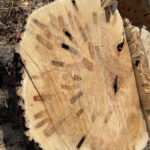
A slice of history.
Scars in a tree at the Indian Creek Nature Center reveal maple syruping history.
Back in 1979 Rich Patterson and volunteers approached a husky Box Elder tree, armed with a drill, spile, and buckets. It was early March. Nights were cold and frosty, followed by warm sunny days. Syrupin’ weather.
Oozing Out the Sap
As soon as the drill’s bit cut through the tree’s bark, clear watery sap oozed out.
Rich gently tapped in a metal spile and hung a bucket under it. By day’s end, two gallons of clear sap nearly filled the pail ready to be boiled into syrup.
- The spile angles slightly downward.
- Visitors and plastic bag on tree
If not overdone tapping just harvests a small percentage of a tree’s sap. It’s sort of like a person giving blood. Taking a little does no harm. Healthy trees quickly create a scab over the tap hole, somewhat like a human body heals a scratch. As the tree grows and its trunk diameter swells, wood forms over the old tap hole. It’s fine to tap that tree again next year, the year after, and every following year.
Syruping season ends when night temperatures don’t drop below freezing. That’s when spiles are pulled, leaving the hole for the tree to heal.
Aging Out of Production
That’s what happened to the Nature Center’s tree. Box Elders are true maples capable of producing sap for quality syrup, but they are short-lived. An 80-year-old Box Elder is, well, elder and near life’s end. After being tapped for 40 years in a row the Nature Center’s box elder reached the end of its days converting solar energy into sugar. After its death staff felled it, revealing at least 30 tap scars. The oldest ones are closest to the center of the tree’s trunk.
Syruping is a fun late winter activity. To learn more visit the Indian Creek Nature Center during syruping season. It holds a fun Maple Syrup Festival in late March each year. For details check out Indian Creek Nature Center’s website.
Thanks, box elder for sharing some of your sap all these years.
- Tasting sap from a sumac spile
- Syrupin’ time is upon us!

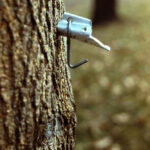
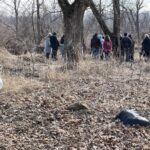
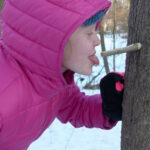
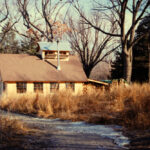

What a delightful article on your history of tapping box elders! Bringing your New England roots to eastern Iowa has surely been a keystone of the success of the Indian Creek Nature Center. And I’ve been so spoiled by real maple syrup, originally stored in an old grain silo, that I judge a breakfast place by the availability of the real deal. Log Cabin and other syrups won’t do anymore! Thank you!
thanks, Sigrid.
Love this article, especially on a snowy day!
thanks, Kristen. M~
The first “maple” I ever tapped was a Box Elder. Great, sweet syrup. I just collected enough sap for about one pancake after boiling it down. This was when I was a poor graduate student.I had a little extra, so I took it into the grad student office so everyone could have a taste. One grad student then proceeded to tap several maple trees around campus.
Thanks Gordon. M~
I can still remember all these years and a new century later watching my father cut the holes in the huge maple tree in our front yard to insert the tap and hang the pail. He also tapped numerous maples in the area. Then as a bucket filled he retrieved it, taking it around to the backyard where he had this huge cast iron wood stove. On top was perched a gigantic pot simmering with sap. Always a large pile of cut wood waited nearby to keep the fire burning.
Then once we had syrup made, he patted down new snow in a flat pan and poured the new
syrup. We watched it congeal into homemade candy. What a great memory I have!
Blessings, Jac
This is a great memory, Jackie!
Thanks for sharing.